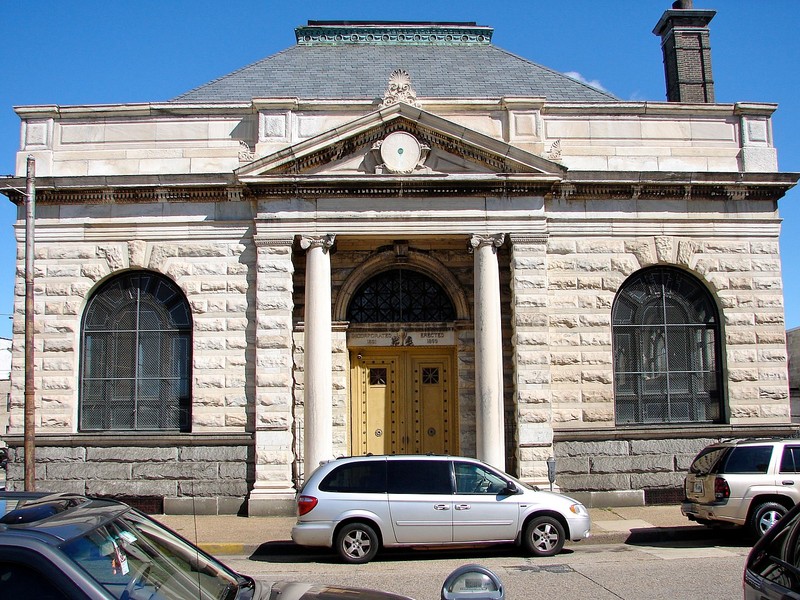Central Trust Company
Introduction
Text-to-speech Audio
Images
Central Trust Bank in Camden, NJ, circa 1899.

Backstory and Context
Text-to-speech Audio
Two canners formed a company that evolved into Campbell Soup, and one of those canners also created the Central Trust Company, which played a significant role in the history of Camden's banking history. Founded in 1891, it operated in Camden's central downtown business district until 1927 when it merged with Camden Safe Deposit and Trust Company. Thomas Stephan, one of Camden's most renowned architects, designed the building in the Second Renaissance Revival style.
Abraham Anderson, a tinner, was one of the nation's earliest canners and went into partnership with Joseph Campbell in 1869 to form a business that eventually became Campbell Soup. Although Anderson and Campbell broke up their partnership, Anderson's canning business continued in Camden. In 1891, Anderson partnered with other business leaders to organize the Central Trust Company, which opened for business in 1892. By 1899, the Trust Company's growth pushed Anderson and partners to pursue the construction of a larger building, so they hired lauded architect Thomas Stephen to design the new building.
Stephan designed the one-story, modest-sized bank building in the Second Renaissance Revival style with influence from the Beaux Arts tradition. When it opened, it was only half the size of the building that now stands in Camden. The bank's economic growth soared both before and after the historic bank building opened; deposits grew from $356.88 in 1891 to $2,267,220.64 in 1916. Thus, the bank needed to expand its physical structure, as well. Three years later, in 1919, the bank again expanded when a rear addition doubled its total size.
Central Trust Company operated independently until 1927, during the peak of the city's and nation's economic boom. That year, the bank merged with Camden Safe Deposit and Trust Company, which later went by the Camden Trust Company. The newly merged bank served as one of the city's three banks. By World War II, the Camden Trust had acquired two other banks, the American National Bank at Broadway and Amber Street in South Camden, and the East End Trust on Federal Street in East Camden. After the war, in 1948, the Camden Trust stood as the largest bank in South Jersey, and seventh largest in the state.
Shortly after the 1927 merger, in 1931, the bank vacated the historic building. The Great Depression made it tough to find a new tenant, hence it remained vacant until a skating arena moved into the facility in 1940. The Equitable Beneficial Insurance company moved into the building in 1947, restoring its purpose as a professional office building. Equitable maintained an office in the building until 2003, thus making it a much longer occupant than the building's namesake, Central Trust Company.
Engraved in the stone above the door are words that read "Incorporated 1891" on one side and "Erected 1899" on the other side. The engraving speaks to the building's history as well as the town's economic growth from the late nineteenth century through the 1920s. Other structures such as the Woodruff Law Buildings (1920) and Wilson Building (1926) also demonstrate the city's maturation from a small Philadelphia suburb known for its industry into a growing economic center. The Great Depression profoundly altered the town's history, but the bank (by merging with Camden Trust) continued to expand even in the midst of economic decline.
Cite This Entry
Admin, Clio and Mathew Powers. "Central Trust Company." Clio: Your Guide to History. January 18, 2021. Accessed March 13, 2025. https://theclio.com/entry/124732
Sources
Powers, Mathew and Clio Admin. "A.S. Woodruff and Law Buildings." Clio: Your Guide to History. January 11, 2021. Accessed January 12, 2021. https://www.theclio.com/entry/124657.
Powers, Mathew and Clio Admin. "Wilson Building in Camden, New Jersey." Clio: Your Guide to History. January 2, 2021. Accessed January 12, 2021. https://www.theclio.com/entry/124224
Thompson, Priscilla M. and Franklyn M. Thompson. "Central Trust Company" National Register of Historic Places. nps.gov. January 5, 2005. https://npgallery.nps.gov/GetAsset/ed8dd60e-55a4-4520-9013-b419ce02df74/.
By Smallbones - Own work, Public Domain, https://commons.wikimedia.org/w/index.php?curid=11438917

